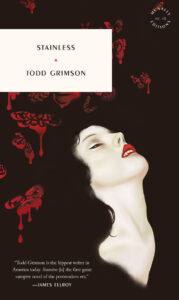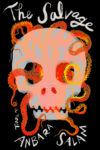
[McNally Editions; 2025]
Describing the dorky intricacies of vampire fiction (and its lesser cousins, werewolf novels and zombie books) often feels mildly embarrassing. Blame it on the monster dreck—The Orc from the Office, The Castle of Count Shagula, Going Steady with the Yeti —that dominate BookTok. But Todd Grimson’s 1996 vamp novel Stainless, recently exhumed and reissued by the good people at McNally Editions, poses no such problems. Besides, he offers a wonderfully succinct synopsis on the book’s second page: “Justine is a vampire, and Keith is the human she keeps around to take care of things during the day.” I was incapable of coming up with such an elegant formulation when asked what, exactly, Stainless was about. “It’s about a vampire and a rockstar who live together,” I would say, watching my interlocutor’s attention drift. “They fall in love…his fingers are broken and he can’t play the guitar anymore…”. Finally, having lost their interest altogether, I’d throw a few labels their way, hoping to win them back: LA novel? 90s neo-noir? Literary horror? Stainless is all of those things: a noirish portrait of the seamy side of Los Angeles in the 90s, populated by some sad, sexy vampires, deadbeat metalheads, and a Hollywood-obsessed villain. Eventually, I gave up trying to make the book sound respectable and just started describing it.
Keith, the human, was the frontman of a successful rock band called SMX (pronounced smacks, a merciful improvement on their former handle, “Cum”). He was dating a supermodel named Renata Spengler. SMX was on a European tour. Then Renata killed herself while she and Keith were in Venezuela. A few days later, her brutish ex-boyfriend Gilberto and his gang of thugs tracked down Keith and broke all his fingers. No longer able to play the guitar, Keith became addicted to painkillers and later, heroin, taking it “for the pain and to blot out all thought.” Then he met Justine, born in the French countryside four hundred years ago, bitten by a local vampire in her long-ago youth, forced to haunt the night ever since. She bites Keith, but thanks to a “highly evolved faculty of taste” apparently common to all vampires, she rejects his heroin-heavy blood. Instead, Justine installs him in her Los Feliz mansion, “Maybe because he loved a dead girl, or because he has known suffering, or perhaps simply because he was handsome.” Although “the full creepiness of the situation is not lost” on Keith, he rolls with it. What else does he have going on? The vampire and the ex-rocker make a mournful pair: he with his ruined hands, she with her sad nocturnal life. He needs heroin; she needs blood. He has nothing left to live for; she hasn’t truly lived in centuries.
The two spend their nights gliding around Los Angeles, “a city of extras, of extra people, homeless and runaways, people without names.” Some of these nameless Angelenos fall victim to Justine’s bloodthirst, which Grimson assures us does not require “anything like the scale of killing someone every night.” These scenes are described with erotic relish: Justine’s victims follow her willingly, longing for “that sweet dangerous amnesiac high.” “In the bedroom,” he writes, “she has Tamara undress… Justine assists the somnolent one, pulling down the pantyhose. In lacy rose-beige bra and underpants, Tamara lies on her side on the bed. Justine pushes her gently onto her stomach, and bites into the good blue vein behind the right knee. It is excellent, hot blood.”
Grimson’s prose, however, is anything but hot-blooded. It is liquid nitrogen cool. In interviews, Grimson talks about “cinematic realism,” a vaguely defined idea that apparently animated the writing of Stainless. “I was trying to connect with a notion I had that our dreams and memories are influenced by Hollywood films, that this is how many of us see things now,” he told an interviewer in 2012. “This is not something I want science to ever understand.” I don’t quite understand it either, other than to guess that Grimson, who was in his mid-forties, flat broke, and living with multiple sclerosis by the time Stainless was published, was hopeful his novel might catch the eye of some hip Hollywood producer. Grimson was certainly aware that vampires were hot again—Anne Rice’s Interview with the Vampire (1974) had been adapted into a hugely lucrative film just two years before Stainless came out. He was not coy about his ambition. Describing the process of writing Stainless, he told another interviewer that he “wanted to write the Final, Ultimate Vampire Novel. I read all that was out there, brooded for a month.”
But suggesting that Stainless was written solely as a cash grab in the wake of Interview with the Vampire does the novel a disservice. Grimson had been mentored by Paul Bowles in Tangier and considered Katherine Dunn a close friend. He read Cesare Pavese and Dennis Cooper, Robert Stone and Mary Gaitskill (“I like [her] to a point,” he sniffed), A.M. Homes, Nam Le and Deborah Eisenberg. “He reads more than anyone I’ve ever known,” Katherine Dunn commented in a 2011 profile of Grimson, “and he takes it all in.”
There are whiffs of Robert Stone and Don DeLillo (another influence) across Stainless, especially in Grimson’s cool, flat, limpid sentences. He’ll set a scene with a line or two: “The air is metallic and worn out, old air recirculated in the warm city’s endless strips. Police helicopters hover, ominous.” We understand immediately that Los Angeles is an exhausted city, a sluggish and tawdry place, its decay matched only by its residents’ spiritual enervation, its air not only “old” but “recirculated,” as if it were an enormous warehouse, rusting and poorly ventilated. Consider the rhythm of these two sentences: The first slumps along, mimicking the heavy air, ending with no clear object (“endless strips”? Strips of what? Strip malls? Highways?). The second snaps crisply to attention. Grimson is a writer for whom the comma is an all-purpose tool, neater than a semi-colon and more honest than a period. Late in the novel, Keith stumbles into a music store and finds a piano, triggering a memory of the night his fingers were broken:
Keith depresses the keys again, so faintly that only the last note sounds of the broken chord. A-flat. It means something to him, this note. He’s suddenly full of anguish, he could cry as he remembers how they came to him, in the cell, smelling of alcohol and sweat, it was so hot, and they held him. At first he didn’t know what they wanted to do.
Not “presses,” or the usual “plays,” but “depresses.” It isn’t subtle in the slightest—this depressed man depresses the keys, producing a “broken chord.” Then comes “A-flat,” landing with a thud. Grimson is not a writer overconcerned with specificity, so the note only means “something” to Keith. The next sentence, with its comma splices and limping rhythm (“…he remembers how they came to him, in the cell, smelling of alcohol and sweat”), staggers and stalls before falling flat at our feet. “They held him”, Grimson writes, “At first he didn’t know what they wanted to do.” It’s thrillingly vague. Grimson doesn’t need to name the violence; he understands that omission, in this case, is far more effective than description.
Stainless is at its best when it surges forward in a moody wave, when it collapses action, perception, and memory into fuzzy sentence-shards. The novel becomes more plotty. A rival vampire and his crew of goth kids threaten Justine and Keith’s budding romance, a pesky journalist noses around, and Grimson takes a ludicrous stab at writing sex scenes: “When he and Justine are fucking, the alchemy of their joining creates a new dark world…a jungle of huge pulpy molten metal fruits and flowers of dripping steel…animals copulating in squishy jewel-like trees, bleeding penises curling…”. You get the picture. Grimson seemed proud of these opium-dream scenes. “I did think that if there’s anything unique I can do in the world of literature,” he remarked in 2011, “it isn’t being another minimalist.”
At first pass, Grimson’s self-assessment is surprising. Stainless is written in a cool, vague, lyrical style that lumps it in with novels by Grimson’s influences and peers: DeLilo, Denis Johnson, James Salter. But Grimson, unlike those writers, had no allegiance to realism. His worlds are baroque and lurid, saturated with fantasy. Stainless, after all, is about vampires. Brand-New Cherry Flavor, his follow-up, adds cults of the undead, biker gangs, Hollywood burnouts and cannibalistic demons.
Grimson’s pride at not having been just “another minimalist” reads less like bravado than a kind of defiance. His first book, Within Normal Limits, was a sober, realist collection of stories about a young doctor in Portland, Oregon, published under the Vintage Contemporaries imprint. When the publisher passed on a second book from Grimson, he pivoted. The result was Stainless, a novel that took years to sell and upon release was broadly panned. “Stainless is all sizzle, no stake,” Joe Queenan opined, reviewing it for the New York Times. Grimson’s agent dropped him. The novel faded from view. Earlier this year, Grimson passed away in a stupid, avoidable accident: En route to a hospital in Portland, a medical transport driver slammed on the brakes, throwing Grimson from his wheelchair, fracturing his leg and leaving him concussed. Oregon ArtsWatch, which carried Grimson’s lone obituary, noted that “Instead of calling for police or an ambulance, Grimson said, the driver put him back in his wheelchair and returned him to his adult foster care home.” He died five days later.
Joe Queenan didn’t get Stainless—you read it for the atmosphere, not the plot. As symbols, vampires have been bled dry, but the genius of Stainless is in its treatment of the vampire not as metaphor but mood. It’s hardly perfect, but Grimson, who once set out to write the Final, Ultimate Vampire Novel, may have accomplished just that. He died recently, quietly and unjustly. Yet Stainless, for all its flaws and fervors, lives on.
Max Callimanopulos lives in Athens, Greece, where he is working on a novel.
This post may contain affiliate links.






